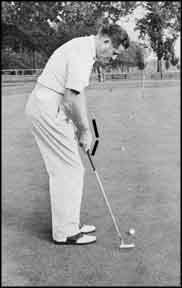
I recently came across this research paper on putting that was on the AimPoint Golf Web site (www.aimpointgolf.com).
You can find the research paper at http://www.aimpointgolf.com/docs/Karlsen2010.pdf
Be warned that it reads like…a research paper. So lots of quoting of other papers and books, lots of descriptions into how the study was executed and less ‘user friendly’ verbiage.
But, they did come up with some interesting findings based on testing over 100 golfers, which included 22 PGA Tour and European Tour players. I’ll try to rattle off their findings:
- As we know, the putterface is more important than the path. They determine that Dave Pelz was pretty much correct in saying that the ball’s initial direction is 83% due to the face and 17% to the path.
- Of the golfer’s studied the variation in their path from stroke to stroke was greater than their variation in the face angle at impact. This surprised me because in the full swing, usually it’s the exact opposite…a golfer’s clubhead path will be very consistently the same while their face angle can be all over the place from shot to shot.
- They studied only right handed golfers and the tendency was for them to aim left at address with the putter. The Tour players averaged about 1* left of the target.
- Here’s a big one, the golfers tested claimed that they *felt* that the mallet putters were easier to aim. HOWEVER, the golfers actually aimed the ‘blade putters’ (i.e. Ping Anser, Ping Zing 2, etc) better. This is because the mallets had big alignment lines and other gadgets like the 2-ball mallet that made it feel like it was easier to aim, but the reality was that they aimed the ‘normal’ style putter better.
- Obviously, there was a correlation between a player’s handicap and their ability to hit putts from 40 feet away close. So it was likely that a player with a 5 handicap would hit 40 footers closer to the cup on average than a player with a 10 handicap.
- Optimally, the putter face should rotate about 1.6*

- Therefore the ‘straight back-straight thru’ stroke (which really doesn’t exist anyway), is considered not optimal.
- Obviously, the optimal ‘face change’ was 0*. Optimally you would like to aim dead at the target (0*) and then return that putterface right back to 0* at impact.
- Small ‘face change’ is okay, but keep it to about 1.5*. I remember that Loren Roberts’ SAM Puttlab report shows a golfer with a 2* closed face at address who then manages to open the blade to 0* at impact. This tells me that while Roberts’ putting stroke looks nice, it’s very compensation oriented putting stroke.
- Downswing time is best at the 270 to 370 millisecond range. The golfers they tested that were out of this range were usually too slow, so a too fast of a downswing usually isn’t the problem.
- Elite players (Tour pros) tend to aim 1* left at address and then open the blade to about 0.4* left at impact.
- Heavier shafts tend to make the ball travel shorter
- They felt that their research showed that more golfers could greatly improve with a heavier putter shaft.
- They strongly feel that green reading is much more important than technique when it comes to having a good speed/touch on a putt.
Overall it was a pretty interesting read once you could siphon thru the typical research paper stuff. My two complaints are that I wish the sample size was bigger and I question some of the books and research they reference.
Sample size (in this case) is the number of golfer’s studied. I believe they tested 116 golfers. IIRC, 100 is actually considered the minimum for a legitimate scientific study. Obviously, the greater the sample size the more accurate the test will depict ‘what really happens.’
While Dave Pelz worked for NASA at one point, I’ve been told that much of his putting research was later proven to not have big enough sample sizes and to be flawed. Thus, referencing his work is a bit questionable if Pelz’s work is considered inaccurate. I’m sure if you want to know more, you could ask Geoff Mangum all about it (www.puttingzone.com)
Still, there’s a lot of interesting things going on here. Particularly with their study of the mallets which helps explain why they continue to grow in popularity. The heavier putter shaft theory is intriguing as well.
3JACK
4 comments:
It's very unfortunate that they didn't research the effectiveness of high-MOI putters.
Seems like simple putter shapes are analogous to blades in that they keep the precision sharper. I always thought the best putters have simpler shaped heads rather than those that have a lot of crap hanging off the back end.
3 years down the line this is still a great find via google. Good work as always, I'll be interested to read the 99page document but the summary you made was good too.
Cheers
3 years down the line this is still a great find via google. Good work as always, I'll be interested to read the 99page document but the summary you made was good too.
Cheers
Post a Comment